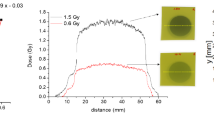Abstract
Purpose
Some recent studies on bendable sensors have reported the reduction of distortion in X-ray shots caused by the patient’s physical structure. In the field of diagnostic radiology, images are nowadays captured using flat panel detectors, but it is difficult to take the geometrical body type and physical characteristics of patients into consideration with flat panels; this may distort images. This study evaluates the bending and electrical properties of bottom electrode-based sensors with bending capability.
Methods
This study evaluates the bending and electrical properties of bottom electrode-based sensors with aluminium, copper, and indium tin oxide films. These sensors are fabricated, and their performance concerning bending resistance, sensitivity, and signal-to-noise ratio are evaluated and compared with a reference sensor.
Results
These sensors are shown to provide similar results to the reference sensor in what concerns the cubic functionality (of approx. 99%) of their response to tube voltage variations. The Al film-based sensor shows he lowest SNR value; the Cu film shows excellent sensitivity, but with a slightly high dark current, resulting in a low SNR value.
Conclusions
Bendable detectors are possible solutions to mitigate the distortion in X-rays obtained with flat panel detector. The results of this study can potentially be used as basic research to support the next-generation bendable detectors, and thus improve these distortions, caused by the X-ray patient’s physical structure.
Similar content being viewed by others
References
Kim HK. Sensor technology for digital radiography. J Kor Soc Precis Eng. 2005; 22(8):7–16.
Ko KW, Koh KC, Kim JH, Lee BY. X-ray imaging system design and analysis for battery inspection. J Kor Soc Precis Eng. 2003; 20(11):32–40.
Lujan RA, Street RA. Flexible X-ray detector array fabricated with oxide thin-film transistors. IEEE Electron Device Lett. 2012; 33(5):688–90.
Goncalves LM, Rocha JG, Lanceros-Mendez S. Flexible X-ray detector based on the Seebeck effect. Conf Proc IEEE Int Symp Ind Electron. 2007; doi: 10.1109/ISIE.2007.4374829.
Oh K, Kim G, Park J, Song Y, Heo S, Cho S, Kim J, Park S, Nam S. Fabrication of thin film x-ray sensor using particle-inbinder method for automatic exposure control in digital radiography. J Inst. 2015; doi: 10.1088/1748-0221/10/03/P03028.
Heo JS, Lee JJ. Development of flexible force sensor using fiber Bragg grating for tactile sensor and its evaluation. J Kor Soc Precis Eng. 2006; 23(2):51–6.
Ryu D-H, Nahm S-H, Kim Y, Kimm S-C. Development of measurement system for crack growth using image processing technology. J Kor Inst Intell Syst. 2002; 17(4):11–8.
Park J, Yoon I, Choi S, Yoon J, Lee Y, Kang S. Study on improvement of signal to noise ratio for HgI2 radiation conversion sensor using blocking layer. J Kor Soc Radiol. 2011; 5(2):97–101.
Kim Y, Yun M, Kim M, Jung S, Kim Y, Oh K, Nam S, Park J. Development of radiation image sensor using heterojunction. J Kor Soc Radiol. 2009; 3(3):27–35.
Kim K-T, Han M-J, Kim J-S, Heo Y-J, Oh K-M, Park J-K, Nam S-H. Structural design of digital radiography detector using hybrid method for the improvement of response property by Xray. J Kor Soc Radiol. 2015; 9(6):363–7.
Oh K, Shin J, Kim S, Lee Y, Jeon S, Kim J, Nam S. The development of efficient X-ray conversion material for digital mammography. J Inst. 2012; doi: 10.1088/1748-0221/7/02/C02009.
Author information
Authors and Affiliations
Corresponding author
Rights and permissions
About this article
Cite this article
Choi, G., Yun, R., Shin, Y. et al. A study of the electrical properties of bottom electrodes for bendable sensors in diagnostic X-ray irradiation. Biomed. Eng. Lett. 6, 26–30 (2016). https://doi.org/10.1007/s13534-016-0216-4
Received:
Revised:
Accepted:
Published:
Issue Date:
DOI: https://doi.org/10.1007/s13534-016-0216-4




